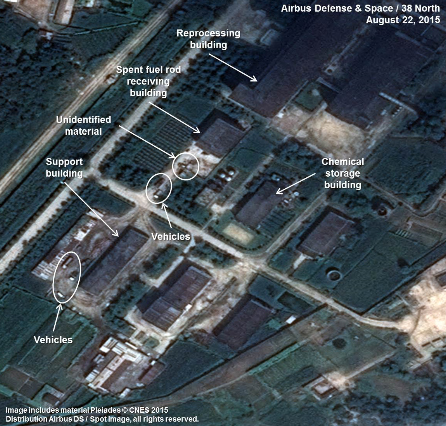North Korea’s evolving nuclear weapons capabilities have returned to the spotlight as it claimed Tuesday that its researchers have been pushing to improve the “quantity and quality” of its nuclear weapons to ensure deterrence against the U.S.
 |
| Satellite imagery shows part of the Yongbyon nuclear complex north of Pyongyang, North Korea. (Yonhap) |
Analysts presume that the North has come a long way in developing nuclear warheads and their delivery means such as long-range rockets, through three nuclear tests in 2006, 2009 and 2013, and a series of rocket tests, disguised as satellite launches.
On Monday, Pyongyang hinted at the possibility of another rocket launch on Oct. 10 to mark the 70th anniversary of the founding of its ruling Workers’ Party. The potential launch would further escalate the North’s missile threats, a reason Seoul has been stepping up its diplomacy to forestall it.
Since its 1998 test of the Taepodong-1 missile, the North has carried out five long-range rocket tests. Experts say the latest test in 2012 showed that its missile can travel some 10,000 kilometers — far enough to reach the U.S. mainland.
Apart from the land-based platform, the North has been pushing to develop the underwater nuclear-capable missile system. In May, it claimed to have carried out an ejection test of a submarine-launched ballistic missile.
The reclusive state has also been seen steadily seeking to accumulate weapons-grade fissile materials through its plutonium-based nuclear program and uranium enrichment activities to build nuclear warheads.
On Tuesday, the North’s Atomic Energy Institute chief claimed that the North restarted all nuclear facilities, including its five-megawatt reactor and uranium enrichment factory at its main Yongbyon nuclear complex.
Seoul’s Vice Foreign Minister Cho Tae-yul said at a general meeting of the International Atomic Energy Agency Tuesday that the North has been steadily running the nuclear reactor at the Yongbyon facility and expanding the facilities for uranium enrichment.
The main five-megawatt reactor is the North’s core facility to produce weapons-grade plutonium. The reactor, should it be fully operational, can produce 6 kilograms of plutonium, the amount to build one nuclear warhead, analysts say.
The North is believed to have accumulated some 40 kilograms of plutonium after it reprocessed spent fuel rods at least three times, in 2003, 2005 and 2009, according to Seoul officials.
Amid its efforts to produce plutonium-based bombs, the North has also been striving to advance its uranium enrichment program, reportedly since the mid-1980s.
The regime has claimed to have some 2,000 operational centrifuges capable of producing some 40 kilograms of highly enriched uranium each year. To produce one HEU bomb, more than 15 kilograms of HEU is required.
Should the North carry out another nuclear test, it could test a “boosted fission weapon,” called a “1.5-generation” nuclear bomb, experts say. The development of this weapon is known to be a preliminary step toward the production of a hydrogen bomb, regarded as a “second-generation” nuclear weapon.
Amid the growing speculation over the North’s fourth nuclear test, the U.S.-based Institute for Science and International Security said that a new facility under construction at the Yongbyon complex appears to be designed to separate isotopes from spent fuel that can be used to produce powerful nuclear weapons.
The North has pushed for its nuclear program in line with its so-called Byungjin policy of simultaneously developing its economy and nuclear arms. The North has already described itself as a nuclear power state in its constitution, a status that the U.S. and South Korea say would never be accepted.
By Song Sang-ho (sshluck@heraldcorp.com)

